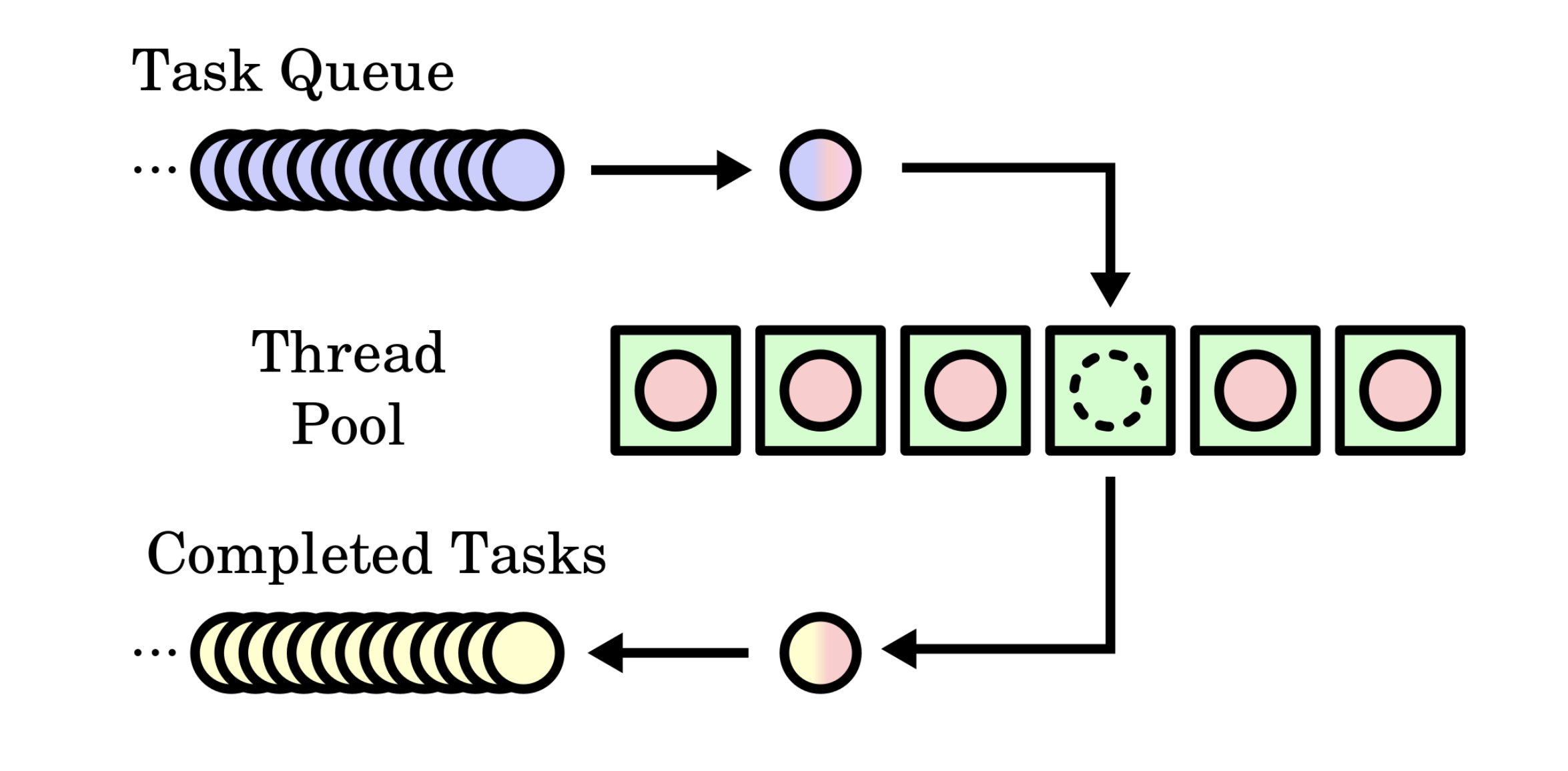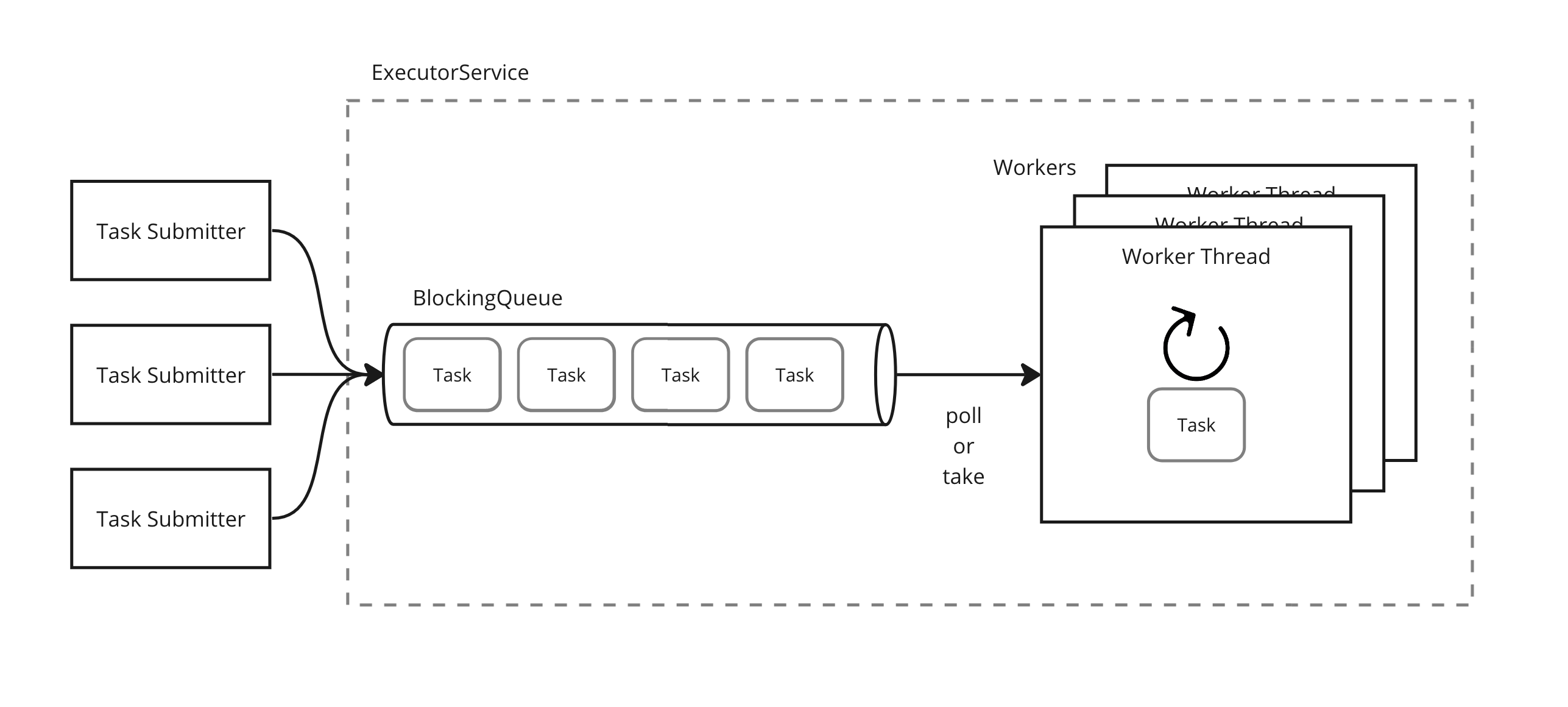Thread Pool in Java
1. Thread Pool
스레드 풀(thread pool)은 프로그램의 동시성 실행을 지원하는 디자인 패턴입니다. 복제된 작업자(replicated workers) 또는 작업자-크루(worker-crew) 모델이라고 불리기도 합니다. 스레드 풀은 여러 개의 스레드들을 유지 관리하고, 풀 내의 스레드들은 작업(task)이 할당되기를 기다립니다.

1.1. Considerations of Thread Pool Usage
스레드 풀은 다음과 같은 문제를 해결하기 위해 사용합니다.
- 짧은 작업을 위해 스레드를 생성, 수거하는데 드는 비용을 줄일 수 있습니다.
- 스레드 생성과 수거는 운영체제 자원을 사용하기 때문에 비용이 큽니다.
- 미리 생성해 둔 스레드에 작업을 할당하기 때문에 실행 지연을 줄일 수 있습니다.
스레드 풀을 사용하려면 처리할 작업량을 고려해야 합니다.
- 스레드 풀을 통해 처리할 작업의 양을 고려하여 자원을 할당해야 합니다.
- 처리할 작업에 비해 너무 많은 스레드가 생성되어 있다면 메모리 낭비가 발생합니다.
1.2. Structure of Thread Pool in Java
Java에서 제공하는 스레드 풀의 구조를 아래 이미지를 통해 살펴보겠습니다.
- Executors 클래스를 통해 생성되는 스레드 풀은 ExecutorService 인터페이스를 구현한 인스턴스(instance)들입니다.
- 스레드 풀 인스턴스에는 작업을 담는 블록킹 큐(blocking queue)와 작업자 스레드(worker thread)들이 담긴 해시셋(HashSet)이 존재합니다.
- 블록킹 큐에서 작업을 꺼내어 작업자 스레드에게 전달합니다.
- 블록킹 큐에서 작업을 꺼낼 때 타임아웃(timeout) 여부에 따라 poll 혹은 take 메소드가 호출됩니다.
- 스레드의 타임아웃 여부는 코어 스레드 개수에 의해 판단됩니다.

2. Types of Thread Pool in Java
JDK 1.5부터 java.util.concurrent 패키지를 통해 동시성에 관련된 기능을 제공하였습니다. Java에서 스레드 풀 기능을 제공하는 주요 인터페이스와 클래스들을 살펴보겠습니다. 이후에 각 스레드 풀의 특징을 살펴보겠습니다.
- Executors 클래스
- 정적 팩토리 메소드 패턴을 통해 스레드 풀 구현체 인스턴스를 생성합니다.
- 이번 포스트에서 살펴볼 정적 팩토리 메소드들은 다음과 같습니다.
- newCachedThreadPool
- newFixedThreadPool
- newScheduledThreadPool
- ExecutorService 인터페이스
- 스레드 풀 기능을 제공하는 클래스들은 ExecutorService 인터페이스를 구현합니다.
- 스레드 풀로써 제공해야하는 API 기능들을 정의되어 있습니다.
- ExecutorService 인터페이스로 추상화 된 메소드들을 통해 스레드 풀 기능들을 활용할 수 있습니다.
- ThreadPoolExecutor 클래스
- ExecutorService 인터페이스의 구현체 클래스입니다.
- 생성자 함수를 살펴보면 다음과 같은 파라미터들을 전달받습니다.
corePoolSize- 스레드 풀에 반드시 유지되어야 하는 스레드 개수입니다.maximumPoolSize- 스레드 풀에 저장할 수 있는 최대 스레드 개수입니다.keepAliveTime- 스레드 수가 코어 수보다 많은 경우, 쉬는 스레드가 종료되기 전에 새 작업을 기다리는 최대 시간입니다.unit-keepAliveTime파라미터에 적용되는 시간 단위입니다.workQueue- 처리되어야하는 작업들이 저장되는 큐입니다.threadFactory- 새로운 스레드를 만들 때 사용하는 팩토리 객체입니다.handler- 큐 용량이 초과되어 작업 실행이 블락되는 경우 사용되는 핸들러 객체입니다.
public class ThreadPoolExecutor extends AbstractExecutorService {
// ...
public ThreadPoolExecutor(int corePoolSize,
int maximumPoolSize,
long keepAliveTime,
TimeUnit unit,
BlockingQueue<Runnable> workQueue,
ThreadFactory threadFactory,
RejectedExecutionHandler handler) {
if (corePoolSize < 0 ||
maximumPoolSize <= 0 ||
maximumPoolSize < corePoolSize ||
keepAliveTime < 0)
throw new IllegalArgumentException();
if (workQueue == null || threadFactory == null || handler == null)
throw new NullPointerException();
this.corePoolSize = corePoolSize;
this.maximumPoolSize = maximumPoolSize;
this.workQueue = workQueue;
this.keepAliveTime = unit.toNanos(keepAliveTime);
this.threadFactory = threadFactory;
this.handler = handler;
}
}
2.1. Cached Thread Pool
newCachedThreadPool 팩토리 메소드를 통해 생성합니다.
해당 스레드 풀은 다음과 같은 특징을 가집니다.
- ThreadPoolExecutor 인스턴스입니다.
- 스레드 풀에서 반드시 유지되어야 하는 코어 스레드 개수는 0 입니다.
- 스레드 풀에 담을 수 있는 최대 스레드 개수는
Integer.MAX_VALUE입니다. - 60초 동안 작업을 할당 받지 못하는 경우 스레드가 종료됩니다.
- 지정된 코어 스레드 개수는 0이므로
keepAliveTime시간이 적용됩니다. - 작업자 스레드가 지정한 시간 동안 작업을 큐에서 꺼내지 못하면 스레드가 스레드 풀에서 제거됩니다.
- 지정된 코어 스레드 개수는 0이므로
- SynchronousQueue 인스턴스에 작업을 담습니다.
- 타임아웃이 존재하므로 내부에서 poll 메소드가 수행됩니다.
public class Executors {
// ...
public static ExecutorService newCachedThreadPool() {
return new ThreadPoolExecutor(0, Integer.MAX_VALUE,
60L, TimeUnit.SECONDS,
new SynchronousQueue<Runnable>());
}
}
2.1.1. Practice
- 10개의 작업을 전달한 후 스레드 풀 사이즈를 확인합니다.
- 60초 대기 후 스레드 풀 사이즈를 확인합니다.
package action.in.blog;
import lombok.extern.slf4j.Slf4j;
import org.junit.jupiter.api.Test;
import java.util.concurrent.ExecutorService;
import java.util.concurrent.Executors;
import java.util.concurrent.ThreadPoolExecutor;
import static org.hamcrest.MatcherAssert.assertThat;
import static org.hamcrest.core.IsEqual.equalTo;
@Slf4j
class CachedThreadPoolTests {
void waitFor(long milliseconds) {
try {
Thread.sleep(milliseconds);
} catch (InterruptedException e) {
throw new RuntimeException(e);
}
}
void submitTasks(int taskCount, ExecutorService executorService, Runnable runnable) {
for (int index = 0; index < taskCount; index++) {
executorService.submit(runnable);
}
}
@Test
void thread_is_removed() {
int taskCount = 10;
ExecutorService executorService = Executors.newCachedThreadPool();
submitTasks(taskCount, executorService, () -> {
log.info("Hello World");
});
int poolSize = ((ThreadPoolExecutor) executorService).getPoolSize();
assertThat(poolSize, equalTo(10));
waitFor(60010);
int poolSizeAfterWait = ((ThreadPoolExecutor) executorService).getPoolSize();
assertThat(poolSizeAfterWait, equalTo(0));
}
}
Result of Practice
- 테스트 로그
- 각 작업이 들어올 때마다 풀에서 사용되는 스레드가 모두 다른 것을 확인할 수 있습니다.
- 테스트 코드 통과
- 작업을 전달한 직후 스레드 풀 사이즈가 10 입니다.
- 60초 뒤에 스레드 풀 사이즈가 0 입니다.
22:35:57.445 [pool-1-thread-7] INFO action.in.blog.CachedThreadPoolTests -- Hello World
22:35:57.445 [pool-1-thread-6] INFO action.in.blog.CachedThreadPoolTests -- Hello World
22:35:57.445 [pool-1-thread-10] INFO action.in.blog.CachedThreadPoolTests -- Hello World
22:35:57.445 [pool-1-thread-2] INFO action.in.blog.CachedThreadPoolTests -- Hello World
22:35:57.445 [pool-1-thread-1] INFO action.in.blog.CachedThreadPoolTests -- Hello World
22:35:57.445 [pool-1-thread-9] INFO action.in.blog.CachedThreadPoolTests -- Hello World
22:35:57.445 [pool-1-thread-4] INFO action.in.blog.CachedThreadPoolTests -- Hello World
22:35:57.445 [pool-1-thread-8] INFO action.in.blog.CachedThreadPoolTests -- Hello World
22:35:57.445 [pool-1-thread-5] INFO action.in.blog.CachedThreadPoolTests -- Hello World
22:35:57.445 [pool-1-thread-3] INFO action.in.blog.CachedThreadPoolTests -- Hello World
2.2. Fixed Thread Pool
newFixedThreadPool 팩토리 메소드를 통해 생성합니다.
해당 스레드 풀은 다음과 같은 특징을 가집니다.
- ThreadPoolExecutor 인스턴스입니다.
- 스레드 풀에서 반드시 유지되어야 하는 코어 스레드 수는 파라미터로 전달 받은
nThreads값입니다. - 스레드 풀에 담을 수 있는 최대 스레드 수는 파라미터로 전달 받은
nThreads값입니다. - 0초 동안 작업을 할당 받지 못하는 경우 스레드가 종료됩니다.
- 지정된 코어 스레드 개수는 0이 아니라면
keepAliveTime시간이 적용되지 않습니다. - 작업이 없다면 얻을 때까지 대기하므로 실제 스레드의 개수는 줄어들지 않습니다.
- 지정된 코어 스레드 개수는 0이 아니라면
- LinkedBlockingQueue 인스턴스에 작업을 담습니다.
- 타임아웃이 없으므로 내부에서 take 메소드를 통해 작업을 얻습니다.
public class Executors {
// ...
public static ExecutorService newFixedThreadPool(int nThreads) {
return new ThreadPoolExecutor(nThreads, nThreads,
0L, TimeUnit.MILLISECONDS,
new LinkedBlockingQueue<Runnable>());
}
}
2.2.1. Practice
- 10개의 작업을 전달한 후 스레드 풀 사이즈를 확인합니다.
- 5초 대기 후 스레드 풀 사이즈를 확인합니다.
package action.in.blog;
import lombok.extern.slf4j.Slf4j;
import org.junit.jupiter.api.Test;
import java.util.concurrent.ExecutorService;
import java.util.concurrent.Executors;
import java.util.concurrent.ThreadPoolExecutor;
import static org.hamcrest.MatcherAssert.assertThat;
import static org.hamcrest.core.IsEqual.equalTo;
@Slf4j
class FixedThreadPoolTests {
void waitFor(long milliseconds) {
try {
Thread.sleep(milliseconds);
} catch (InterruptedException e) {
throw new RuntimeException(e);
}
}
void submitTasks(int taskCount, ExecutorService executorService, Runnable runnable) {
for (int index = 0; index < taskCount; index++) {
executorService.submit(runnable);
}
}
@Test
void thread_pool_size_is_not_changed() {
int taskCount = 10;
ExecutorService executorService = Executors.newFixedThreadPool(5);
submitTasks(taskCount, executorService, () -> {
log.info("Hello World");
});
int poolSize = ((ThreadPoolExecutor) executorService).getPoolSize();
assertThat(poolSize, equalTo(5));
waitFor(5000);
int poolSizeAfterWait = ((ThreadPoolExecutor) executorService).getPoolSize();
assertThat(poolSizeAfterWait, equalTo(5));
}
}
Result of Practice
- 테스트 로그
- 10개의 작업을 5개의 스레드가 나눠서 수행하는 것을 확인할 수 있습니다.
- 테스트 코드 통과
- 작업을 전달한 직후 스레드 풀 사이즈가 5 입니다.
- 5초 뒤에 스레드 풀 사이즈가 5 입니다.
07:29:30.819 [pool-1-thread-4] INFO action.in.blog.FixedThreadPoolTests -- Hello World
07:29:30.819 [pool-1-thread-2] INFO action.in.blog.FixedThreadPoolTests -- Hello World
07:29:30.819 [pool-1-thread-1] INFO action.in.blog.FixedThreadPoolTests -- Hello World
07:29:30.819 [pool-1-thread-3] INFO action.in.blog.FixedThreadPoolTests -- Hello World
07:29:30.819 [pool-1-thread-5] INFO action.in.blog.FixedThreadPoolTests -- Hello World
07:29:30.823 [pool-1-thread-4] INFO action.in.blog.FixedThreadPoolTests -- Hello World
07:29:30.823 [pool-1-thread-2] INFO action.in.blog.FixedThreadPoolTests -- Hello World
07:29:30.824 [pool-1-thread-1] INFO action.in.blog.FixedThreadPoolTests -- Hello World
07:29:30.824 [pool-1-thread-3] INFO action.in.blog.FixedThreadPoolTests -- Hello World
07:29:30.824 [pool-1-thread-5] INFO action.in.blog.FixedThreadPoolTests -- Hello World
2.3. Scheduled Thread Pool
newScheduledThreadPool 팩토리 메소드를 통해 생성합니다.
해당 스레드 풀은 다음과 같은 특징을 가집니다.
- ScheduledThreadPoolExecutor 인스턴스입니다.
- ScheduledThreadPoolExecutor는 ThreadPoolExecutor 클래스를 확장한 클래스입니다.
- ScheduledExecutorService 인터페이스를 반환합니다.
- ScheduledExecutorService는 ExecutorService 인터페이스를 확장한 인터페이스입니다.
- 스레드 풀에서 반드시 유지되어야 하는 코어 스레드 수는 파라미터로 전달 받은
corePoolSize값입니다. - 스레드 풀에 담을 수 있는 최대 스레드 수는 파라미터로 전달 받은
Integer.MAX_VALUE값입니다. - 10ms 동안 작업을 할당 받지 못하는 경우 스레드가 종료됩니다.
- 코어 풀 사이즈가 0인 경우 작업을 10ms 동안 획득하지 못하면 스레드가 풀에서 제거됩니다.
- 코어 풀 사이즈가 1 이상인 경우 작업을 획득하지 못하더라도 스레드 풀에서 제거되지 않습니다.
- DelayedWorkQueue 인스턴스에 작업을 담습니다.
- 코어 풀 사이즈가 0인 경우 내부에서 poll 메소드를 통해 작업을 얻습니다.
- 코어 풀 사이즈가 1 이상인 경우 내부에서 take 메소드를 통해 작업을 얻습니다.
public class Executors {
// ...
public static ScheduledExecutorService newScheduledThreadPool(int corePoolSize) {
return new ScheduledThreadPoolExecutor(corePoolSize);
}
}
public class ScheduledThreadPoolExecutor extends ThreadPoolExecutor implements ScheduledExecutorService {
// ...
public ScheduledThreadPoolExecutor(int corePoolSize) {
super(corePoolSize, Integer.MAX_VALUE,
DEFAULT_KEEPALIVE_MILLIS, MILLISECONDS,
new DelayedWorkQueue());
}
}
2.3.1. Practice
- 두 테스트를 통해 동작을 살펴보겠습니다.
- run_scheduled_task 메소드
- 코어 사이즈를 5로 지정합니다.
- 10개의 작업을 전달합니다.
- 1개의 작업은 1초 뒤에 실행되도록 스케줄링합니다.
- 스레드 풀 사이즈를 확인합니다.
- 5초 대기 후 스레드 풀 사이즈를 확인합니다.
- remove_thread_when_core_size_zero 메소드
- 코어 사이즈를 0으로 지정합니다.
- 10개의 작업을 전달합니다.
- 스레드 풀 사이즈를 확인합니다.
- 50ms 대기 후 스레드 풀 사이즈를 확인합니다.
package action.in.blog;
import lombok.extern.slf4j.Slf4j;
import org.junit.jupiter.api.Test;
import java.util.concurrent.*;
import static org.hamcrest.MatcherAssert.assertThat;
import static org.hamcrest.core.IsEqual.equalTo;
@Slf4j
class ScheduledThreadPoolTests {
void waitFor(long milliseconds) {
try {
Thread.sleep(milliseconds);
} catch (InterruptedException e) {
throw new RuntimeException(e);
}
}
void submitTasks(int taskCount, ExecutorService executorService, Runnable runnable) {
for (int index = 0; index < taskCount; index++) {
executorService.submit(runnable);
}
}
@Test
void run_scheduled_task() throws InterruptedException {
int taskCount = 10;
ScheduledExecutorService executorService = Executors.newScheduledThreadPool(5);
executorService.schedule(() -> {
log.info("Run at last");
}, 1000, TimeUnit.MILLISECONDS);
submitTasks(taskCount, executorService, () -> {
log.info("Hello World");
});
int poolSize = ((ThreadPoolExecutor) executorService).getPoolSize();
assertThat(poolSize, equalTo(5));
waitFor(5000);
int poolSizeAfterWait = ((ThreadPoolExecutor) executorService).getPoolSize();
assertThat(poolSizeAfterWait, equalTo(5));
}
@Test
void remove_thread_when_core_size_zero() throws InterruptedException {
int taskCount = 10;
ScheduledExecutorService executorService = Executors.newScheduledThreadPool(0);
submitTasks(taskCount, executorService, () -> {
log.info("Hello World");
});
int poolSize = ((ThreadPoolExecutor) executorService).getPoolSize();
assertThat(poolSize, equalTo(1));
waitFor(50);
int poolSizeAfterWait = ((ThreadPoolExecutor) executorService).getPoolSize();
assertThat(poolSizeAfterWait, equalTo(0));
}
}
Result of Practice
- run_scheduled_task 메소드 수행 결과입니다.
- 테스트 로그
- 10개의 작업을 5개의 스레드가 나눠서 수행하는 것을 확인할 수 있습니다.
- 첫번째 작업 1초 뒤에
Run at last로그가 출력된 것을 확인할 수 있습니다.
- 테스트 코드 통과
- 작업을 전달한 직후 스레드 풀 사이즈가 5 입니다.
- 5초 뒤에 스레드 풀 사이즈가 5 입니다.
07:04:37.632 [pool-1-thread-3] INFO action.in.blog.ScheduledThreadPoolTests -- Hello World
07:04:37.632 [pool-1-thread-5] INFO action.in.blog.ScheduledThreadPoolTests -- Hello World
07:04:37.635 [pool-1-thread-3] INFO action.in.blog.ScheduledThreadPoolTests -- Hello World
07:04:37.632 [pool-1-thread-4] INFO action.in.blog.ScheduledThreadPoolTests -- Hello World
07:04:37.632 [pool-1-thread-1] INFO action.in.blog.ScheduledThreadPoolTests -- Hello World
07:04:37.632 [pool-1-thread-2] INFO action.in.blog.ScheduledThreadPoolTests -- Hello World
07:04:37.635 [pool-1-thread-5] INFO action.in.blog.ScheduledThreadPoolTests -- Hello World
07:04:37.636 [pool-1-thread-3] INFO action.in.blog.ScheduledThreadPoolTests -- Hello World
07:04:37.636 [pool-1-thread-4] INFO action.in.blog.ScheduledThreadPoolTests -- Hello World
07:04:37.636 [pool-1-thread-1] INFO action.in.blog.ScheduledThreadPoolTests -- Hello World
07:04:38.632 [pool-1-thread-2] INFO action.in.blog.ScheduledThreadPoolTests -- Run at last
- remove_thread_when_core_size_zero 메소드 수행 결과입니다.
- 테스트 로그
- 10개의 작업을 1개의 스레드가 수행하는 것을 확인할 수 있습니다.
- 테스트 코드 통과
- 작업을 수행하는 동안 스레드 풀 사이즈가 1 입니다.
- 50ms 뒤에 스레드 풀 사이즈가 0 입니다.
07:51:01.347 [pool-1-thread-1] INFO action.in.blog.ScheduledThreadPoolTests -- Hello World
07:51:01.351 [pool-1-thread-1] INFO action.in.blog.ScheduledThreadPoolTests -- Hello World
07:51:01.351 [pool-1-thread-1] INFO action.in.blog.ScheduledThreadPoolTests -- Hello World
07:51:01.351 [pool-1-thread-1] INFO action.in.blog.ScheduledThreadPoolTests -- Hello World
07:51:01.351 [pool-1-thread-1] INFO action.in.blog.ScheduledThreadPoolTests -- Hello World
07:51:01.351 [pool-1-thread-1] INFO action.in.blog.ScheduledThreadPoolTests -- Hello World
07:51:01.351 [pool-1-thread-1] INFO action.in.blog.ScheduledThreadPoolTests -- Hello World
07:51:01.352 [pool-1-thread-1] INFO action.in.blog.ScheduledThreadPoolTests -- Hello World
07:51:01.352 [pool-1-thread-1] INFO action.in.blog.ScheduledThreadPoolTests -- Hello World
07:51:01.352 [pool-1-thread-1] INFO action.in.blog.ScheduledThreadPoolTests -- Hello World
CLOSING
ForkJoinPool 클래스도 스레드 풀의 종류 중 하나입니다. Executors 클래스를 사용하면 ForkJoinPool 인스턴스를 생성할 수 있습니다. 스레드 풀 개선을 위해 JDK1.7에서 추가되었으며 이번 포스트에 함께 정리하기엔 내용이 많아 별도로 정리할 예정입니다.

댓글남기기